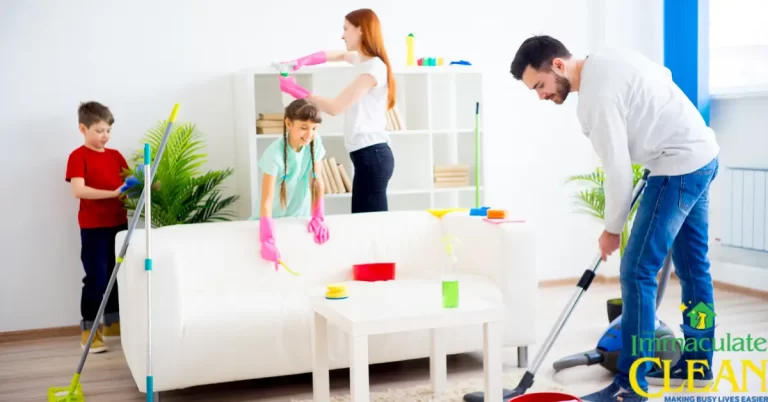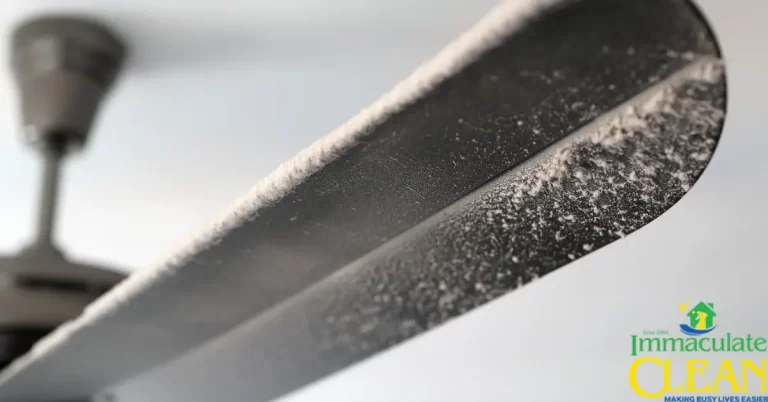You wipe it, you vacuum it up, you even get special gadgets to trap it, but it comes back relentlessly day after day. What are we talking about? That would be dust! We are familiar with your daily struggle of keeping the dust at bay and as a Maryland cleaning company we help home and business owners like you the best we can. But don’t you wonder sometimes what “dust” actually is and why it keeps coming back? We were curious about that too, so we’ve put together this article to offer you more insight into dust and how to fight it.
What Dust is Made of
Before we get to figuring out the sources of dust in your home, let’s first take a look at what dust is made of—this will give you some clues. The science tells us that dust is a cocktail made of the following main ingredients:
- dead skin that we shed (about 70% of dust)
- pet dander (dead skin that your pets shed)
- tiny particles of dirt and sand
- insect feces and dead insect shells (mainly dust mites)
- pollen and mold spores
- fibers from fabrics and paper
Did we gross you out? It’s not that bad! People and animals shedding their skin is a normal process. Now, dust mites feeding on that dead skin may sound a bit unnerving, but in the grand scheme of things it’s unavoidable to share our home with other microorganisms.
Sources of Dust in Your Home
Now that you know what’s in the dust, it’s easy to guess where the dust comes from. Here are some of the major sources of dust in your home and a few tips for neutralizing them.
People and Pets
As we mentioned, shedding dead skin is unavoidable, so there will always be some dead cells floating around in the air. However, you can reduce the amount by maintaining good hygiene and helping your pets do the same. When you shower or wash your pets, you flush dead skin down the drain instead of releasing it into the air.
Outdoors
Dirt, sand and pollen can blow in with the wind from the outside when you have your windows open. Keeping your windows closed all the time is probably not reasonable, but you can avoid opening them during the blooming season. This will help keep pollen out and will help with your allergies.
Fabrics and Paper
Every time you put on new sheets on the bed or tear off a fresh sheet of paper towels, you release hundreds of tiny particles into the air. Older fabrics that are starting to deteriorate may shed more fibers, so replacing them in time could help reduce the dust. If you want to go even further, see where you could replace fabrics that shed with those that don’t. For example, you could swap a microfiber couch for a leather one or get rid of carpets and go with hardwood or tile. And this last tip may sound like common sense, but we often forget to do things like flattening a cardboard box or shaking dog hair off a throw outside.
Carpets
We probably already advised you a few times in this article to get rid of carpets, but we think carpeting deserves its own section. Since many homes have wall-to-wall carpets, especially in bedrooms where we spend close to a third of day, removing carpets could have a huge impact on your indoor air quality. First of all, carpets are made of fabrics, which means they constantly shed tiny fibers. Second of all, carpets tend to trap all the other components of dust and release them back into the air when you walk, jump, play, run or otherwise disturb the surface.
Mold
Mold spores can be found in the outdoor air year around. Sometimes they get inside your home and find a wet and humid area to reproduce. And then you’ve got your own little mold factory contributing to dust and making you sneeze! Watch out for mold by making sure every corner of your home is dry from the inside.
Dust Mites
Interestingly, dust mites both feed on dust and contribute to it. Most homes have them, but levels can be different. To eliminate (or at least reduce) dust mites, the American Lung Association recommends keeping your home humidity below 50% and get rid of carpets, drapes and as many other textile surfaces as you can. Washing your bedding regularly in hot water and damp-moping floors also helps.
Here is a video showing in more detail some steps you could take to minimize the dust mite impact, especially if you are allergic:
Other Tips for Keeping Dust at Bay
Of course, one of the biggest factors in controlling dust is cleaning or “dusting” as some people call it. Make sure to use either a wet cloth or a special microfiber cloth that attracts dust. Otherwise you are just moving it from one place to another when you go over it with a dry rag or with your hand. We understand that cleaning every hard surface in your home on a weekly basis is impossible on your own. Which is why you are welcome to enlist our help!
Dust accumulates on surfaces that are rarely used, like behind the TV or on a book shelf. That’s why you rarely find dust on a kitchen counter or on the stove. The vent hood, top of the fridge and your ceiling fan, however, are a different story. If you haven’t dusted these areas in a while, get in touch with us for a deep cleaning service. We can help you establish a clean slate (pun intended) that will be easier for you to maintain!







